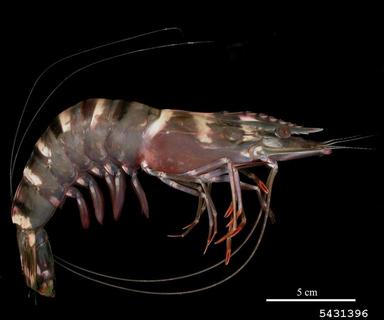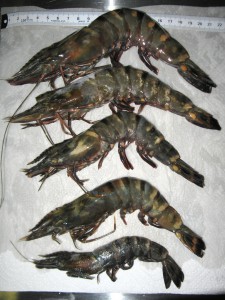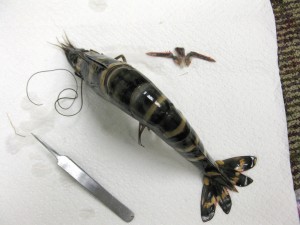Giant Tiger Prawn (Penaeus monodon):
This catchy phrase coined by Robert Turpin (Escambia County Marine Resources Division) describes a recent invader to our marine waters in the past decade. Many coastal residents are aware of the invasive lionfish that has invaded our local reefs but less have probably heard of the Asian Tiger Shrimp. This member of the penaeid shrimp family, the same family are edible white, brown, and pink shrimp come from, was brought to the United States in the 1960’s and 70’s as an aquaculture project. Over the years farmers have moved from Tiger Shrimp to the Pacific White Shrimp and the last known active farm was in 2004.
In 1988, two thousand of these shrimp were lost from a farm in South Carolina during a flood event. Only 10% of those were recaptured and some were collected as far away as Cape Canaveral. No more was heard from this release until 2006 when 6 were captured; one of those in Mississippi Sound near Dauphin Island. Each year since the number of reported captures has increased suggesting they are breeding.
In the Panhandle, one individual was caught in 2011 near Panama City and 5 were collected in 2012 in Pensacola Bay. They have been found in all Gulf coast states and there has been at least 1 record in each of the Florida Panhandle counties. The future impact of this shrimp to our area is still unknown but they have a high tolerance for salinity change and consume many types of benthic invertebrates. Tiger shrimp may out compete our native penaeid shrimps and could possibly feed directly on the juveniles. It is thought that they could possibly transmit diseases to our native shrimp.
Giant Tiger Prawn: This large shrimp, also known as the Asian Tiger Shrimp and the Black Tiger Shrimp, can reach lengths between 8-12 inches. It resembles are native edible penaeid shrimp but differs in that it has distinct black and yellow stripes.
NOAA scientists are interested in obtaining samples of this shrimp for DNA studies. It differs from other local penaid shrimp in that it is larger (8-12” long), dark in color (dark green to black) and has light stripes (white to cream colored). The larva and juveniles live in the bay. Sub adults will migrate offshore for breeding. They are a tropical species that have a low tolerance for cold temperatures, showing no growth below 20°C. If you think you have found one of these shrimp, record size location (GPS preferred), and email information to ExoticReports@MyFWC.com. You can also report to EDDMapS using the website or I’ve Got One! phone app. To learn more about Tiger Prawns view the USGS factsheet.

The nonnative Giant Tiger Prawn – also known as the Black Tiger Shrimp. Photo by David Knott, Bugwood.org
- Tips for Bear Encounters this Fall - November 10, 2025
- Pensacola Bay Invasive Species Summer Survey 2025 - November 3, 2025
- Our Environment: Part 24 – Our Changing Climate - November 3, 2025

![NISAW-logo09[1]](https://nwdistrict.ifas.ufl.edu/nat/files/2014/02/NISAW-logo091-300x119.jpg)

